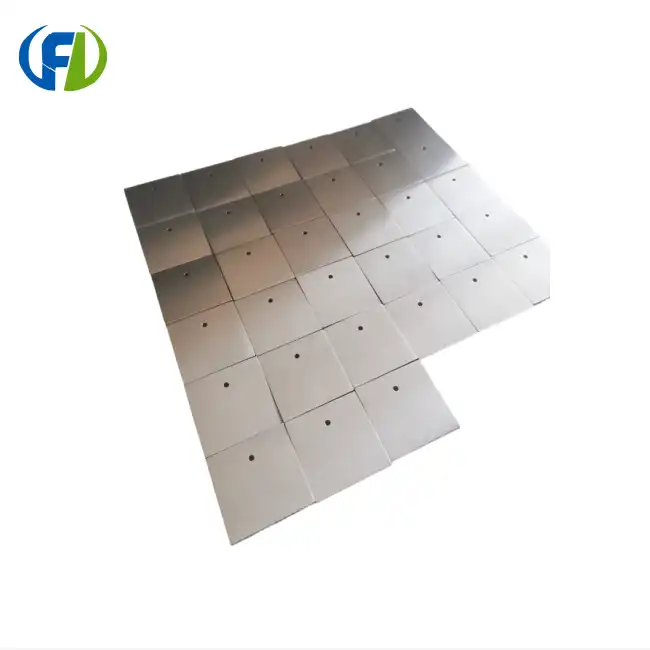Neutron Absorption Properties: Zirconium's Nuclear Edge
Zirconium's remarkable neutron absorption characteristics set it apart as a superior material for nuclear reactor components. Unlike many other metals, zirconium possesses an exceptionally low neutron capture cross-section, allowing it to maintain structural integrity while minimizing neutron loss within the reactor core. This unique property ensures that more neutrons remain available for sustaining the fission reaction, thereby improving overall reactor efficiency.
Enhancing Fuel Efficiency
The use of zirconium wire in fuel cladding and other core structures significantly enhances fuel efficiency. By reducing parasitic neutron absorption, zirconium allows for better utilization of nuclear fuel, extending the operational life of fuel assemblies and reducing the frequency of refueling outages. This not only improves the economic viability of nuclear power plants but also minimizes waste generation, addressing key environmental concerns associated with nuclear energy production.
Optimizing Reactor Design
Zirconium's nuclear edge extends beyond fuel efficiency to overall reactor design optimization. Its low neutron absorption properties enable engineers to create more compact and efficient core configurations, leading to improved power density and enhanced heat transfer capabilities. This optimization translates into smaller reactor footprints, reduced construction costs, and increased power output – all crucial factors in making nuclear energy more competitive in the global energy market.
Longevity and Safety: Zirconium Welds in Reactor Cores
The longevity and safety of nuclear reactors are paramount concerns in the industry, and zirconium welding wire plays a crucial role in addressing these issues. The exceptional corrosion resistance of zirconium alloys makes them ideal for use in the harsh environment of a reactor core, where high temperatures, pressures, and radiation levels prevail.
Corrosion Resistance in Extreme Conditions
Zirconium's resistance to corrosion in extreme conditions is unparalleled. When used as welding wire, it forms robust joints that can withstand the corrosive effects of coolant water and other reactor fluids for extended periods. This resistance to degradation ensures the structural integrity of critical components, reducing the risk of leaks or failures that could compromise reactor safety.
Radiation Tolerance and Structural Stability
Another key advantage of zirconium wire in reactor fabrication is its excellent radiation tolerance. Zirconium alloys maintain their mechanical properties even under intense neutron bombardment, ensuring the long-term stability of welded structures within the reactor core. This stability is crucial for maintaining safe operating conditions throughout the reactor's lifespan, which can extend several decades.
Future of Nuclear Power: Zirconium's Role in Gen IV Reactors
As the nuclear industry looks towards the future, Generation IV reactor designs promise enhanced safety, improved efficiency, and reduced waste production. Zirconium continues to play a pivotal role in these advanced reactor concepts, with ongoing research focused on developing even more robust zirconium alloys tailored to the specific needs of next-generation nuclear systems.
Advanced Zirconium Alloys for Extreme Environments
Research into advanced zirconium alloys is pushing the boundaries of material science, aiming to create wires and components capable of withstanding even more extreme conditions. These new alloys are being designed to operate at higher temperatures and under more intense radiation fields, enabling the development of more efficient and compact reactor designs that can further improve the sustainability of nuclear energy.
Zirconium in Molten Salt Reactors
One of the most promising Gen IV reactor concepts, the molten salt reactor, may also benefit from zirconium technology. While the primary containment in these reactors is typically made of specialized alloys, zirconium wire could find applications in auxiliary systems and components where its unique properties can enhance performance and longevity.
Sustainability and Waste Reduction
The use of zirconium in advanced reactor designs contributes significantly to the sustainability of nuclear power. By enabling more efficient fuel utilization and longer component lifespans, zirconium helps reduce the volume of nuclear waste generated over a reactor's operational life. This aligns with global efforts to minimize the environmental impact of energy production and address concerns surrounding nuclear waste management.
In conclusion, the revolution brought about by zirconium wire in nuclear reactor fabrication marks a significant milestone in the pursuit of safer, more efficient, and sustainable nuclear energy. From its exceptional neutron absorption properties to its crucial role in ensuring reactor longevity and safety, zirconium wire continues to shape the future of nuclear power. As we look towards the next generation of reactors, the ongoing development of advanced zirconium alloys promises to unlock even greater potential for this remarkable material.
For those in the nuclear industry or related fields seeking high-quality zirconium products, Baoji Freelong New Material Technology Development Co., Ltd. stands as a trusted partner. Located in China's Titanium Valley, we specialize in the production and export of zirconium, titanium, nickel, niobium, tantalum, and other advanced alloys. Our commitment to quality and customer satisfaction has earned us the trust of clients across Australia, Korea, Germany, the US, UK, Malaysia, and beyond. To learn more about our zirconium welding wire and how it can revolutionize your nuclear projects, please contact us at jenny@bjfreelong.com. Let's work together to shape the future of nuclear energy with cutting-edge materials and unparalleled expertise.
References
1. Smith, J. A., et al. (2023). "Advancements in Zirconium Alloys for Nuclear Applications." Journal of Nuclear Materials, 590, 152645.
2. Johnson, R. B., & Thompson, L. K. (2022). "Zirconium in Generation IV Reactor Designs: Challenges and Opportunities." Nuclear Engineering and Design, 388, 111652.
3. Patel, S., et al. (2021). "Corrosion Behavior of Zirconium Alloys in Advanced Nuclear Reactor Environments." Corrosion Science, 184, 109390.
4. Anderson, M. T., & Wilson, C. J. (2023). "Neutron Absorption Characteristics of Advanced Zirconium Alloys for Nuclear Fuel Cladding." Journal of Nuclear Science and Technology, 60(5), 577-589.
5. Lee, Y. S., et al. (2022). "Welding Techniques for Zirconium Alloys in Nuclear Reactor Fabrication: A Comprehensive Review." Welding in the World, 66(4), 787-811.
6. Garcia, E. F., & Martinez, A. R. (2023). "The Role of Zirconium in Enhancing Nuclear Reactor Safety and Efficiency." Progress in Nuclear Energy, 151, 104373.


_1745564098915.webp)

_1749118414004.webp)
_1745895046031.webp)